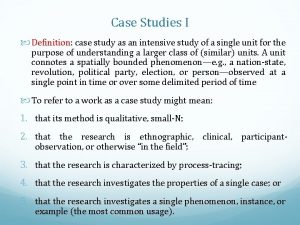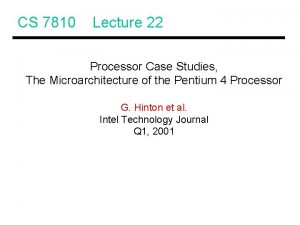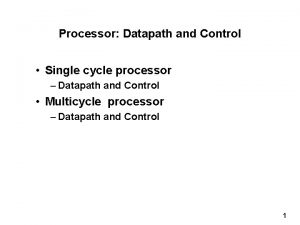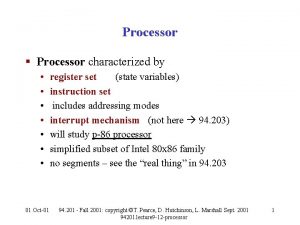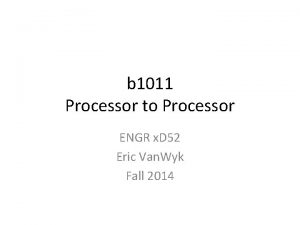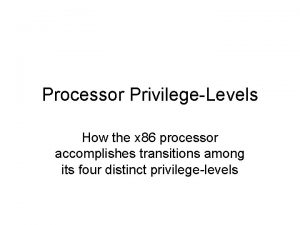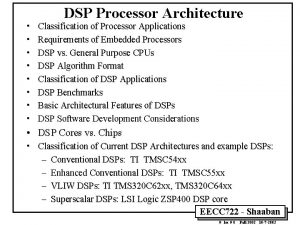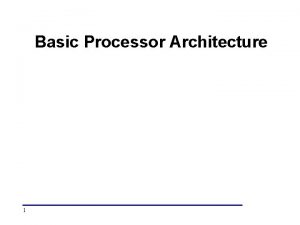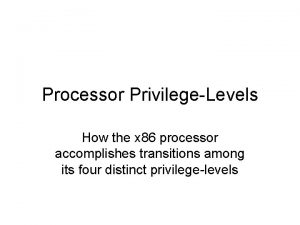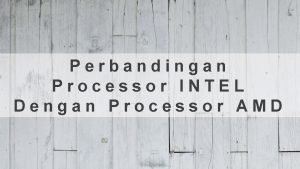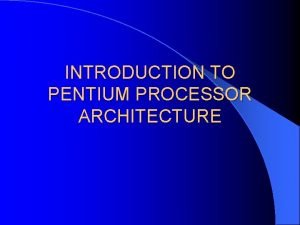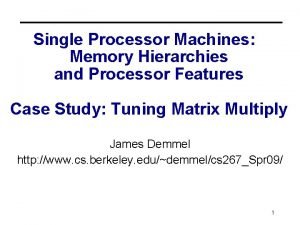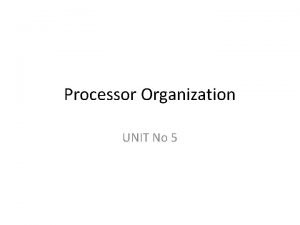Lecture 26 Case Studies Topics processor case studies


















- Slides: 18

Lecture 26: Case Studies • Topics: processor case studies, Flash memory • Final exam stats: § Highest 83, median 67 § 70+: 16 students, 60 -69: 20 students § 1 st 3 problems and 7 th problem: gimmes § 4 th problem (LSQ): half the students got full points § 5 th problem (cache hierarchy): 1 correct solution § 6 th problem (coherence): most got more than 15 points § 8 th problem (TM): very few mentioned frequent aborts, starvation, and livelock § 9 th problem (TM): no one got close to full points § 10 th problem (LRU): 1 “correct” solution with the 1 tree structure

Finals Discussion: LSQ, Caches, TM, LRU 2

Case Study I: Sun’s Niagara • Commercial servers require high thread-level throughput and suffer from cache misses • Sun’s Niagara focuses on: Ø simple cores (low power, design complexity, can accommodate more cores) Ø fine-grain multi-threading (to tolerate long memory latencies) 3

Niagara Overview 4

SPARC Pipe No branch predictor Low clock speed (1. 2 GHz) One FP unit shared by all cores 5

Case Study II: Sun’s Rock • 16 cores, each with 2 thread contexts • 10 W per core (14 mm 2), each core is in-order and 2. 3 GHz (10 -12 FO 4)(65 nm), total of 240 W and 396 mm 2 ! • New features: scout threads that prefetch while the main thread is stalled on memory access, support for HTM (lazy versioning and eager CD) • Each cluster of 4 cores shares a 32 KB I-cache, two 32 KB D-caches (one D-cache for two cores), and 2 FP units. Caches are 4 -way p-LRU. L 2 cache is 4 -banked 8 -way p-LRU and 2 MB. • Clusters are connected with a crossbar switch • Good read: http: //www. opensparc. net/pubs/preszo/08/Rock. ISSCC 08. pdf 6

Rock Overview 7

Case Study III: Intel Pentium 4 • Pursues high clock speed, ILP, and TLP • CISC instrs are translated into micro-ops and stored in a trace cache to avoid translations every time • Uses register renaming with 128 physical registers • Supports up to 48 loads and 32 stores • Rename/commit width of 3; up to 6 instructions can be dispatched to functional units every cycle • Simple instruction has to traverse a 31 -stage pipeline • Combining branch predictor with local and global histories • 16 KB 8 -way L 1; 4 -cyc for ints, 12 -cyc for FPs; 2 MB 8 -way L 2, 18 -cyc 8

Clock Rate Vs. CPI: AMD Opteron Vs P 4 2. 8 GHz AMD Opteron vs. 3. 8 GHz Intel P 4: Opteron provides a speedup of 1. 08 9

Case Study IV: Intel Core Architecture • Single-thread execution is still considered important § out-of-order execution and speculation very much alive § initial processors will have few heavy-weight cores • To reduce power consumption, the Core architecture (14 pipeline stages) is closer to the Pentium M (12 stages) than the P 4 (30 stages) • Many transistors invested in a large branch predictor to reduce wasted work (power) • Similarly, SMT is also not guaranteed for all incarnations of the Core architecture (SMT makes a hotspot hotter) 10

Case Study V: Intel Nehalem • Quad core, each with 2 SMT threads • ROB of 96 in Core 2 has been increased to 128 in Nehalem; ROB dynamically allocated across threads • Lots of power modes; in-built power control unit • 32 KB I&D L 1 caches, 10 -cycle 256 KB private L 2 cache per core, 8 MB shared L 3 cache (~40 cycles) • L 1 d. TLB 64/32 entries (page sizes of 4 KB or 4 MB), 512 -entry L 2 TLB (small pages only) 11

DIMM MC 1 DIMM MC 2 DIMM MC 3 Core 1 Core 2 Core 3 Core 4 Socket 1 Socket 2 QPI DIMM DIMM MC 1 MC 2 MC 3 Core 1 Core 2 Core 3 Core 4 Socket 3 Socket 4 Nehalem Memory Controller Organization

Flash Memory • Technology cost-effective enough that flash memory can now replace magnetic disks on laptops (also known as solid-state disks) • Non-volatile, fast read times (15 MB/sec) (slower than DRAM), a write requires an entire block to be erased first (about 100 K erases are possible) (block sizes can be 16 -512 KB) 13

Advanced Course • Spr’ 09: CS 7810: Advanced Computer Architecture § co-taught by Al Davis and me § lots of multi-core topics: cache coherence, TM, networks § memory technologies: DRAM layouts, new technologies, memory controller design § Major course project on evaluating original ideas with simulators (can lead to publications) § One programming assignment, take-home final 14

Case Studies: More Processors • AMD Barcelona: 4 cores, issue width of 3, each core has private L 1 (64 KB) and L 2 (512 KB), shared L 3 (2 MB), 95 W (AMD also has announcements for 3 -core chips) • Sun Niagara 2: 8 threads per core, up to 8 cores, 60 -123 W, 0. 9 -1. 4 GHz, 4 MB L 2 (8 banks), 8 FP units • IBM Power 6: 2 cores, 4. 7 GHz, each core has a private 4 MB L 2 15

Alpha Address Mapping Virtual address Unused bits Level 1 21 bits Page table base register Level 2 10 bits Level 3 10 bits Page offset 10 bits 13 bits + + PTE L 1 page table + PTE L 2 page table 32 -bit physical page number PTE L 3 page table Page offset 45 -bit Physical address 16

Alpha Address Mapping • Each PTE is 8 bytes – if page size is 8 KB, a page can contain 1024 PTEs – 10 bits to index into each level • If page size doubles, we need 47 bits of virtual address • Since a PTE only stores 32 bits of physical page number, the physical memory can be addressed by at most 32 + offset • First two levels are in physical memory; third is in virtual • Why the three-level structure? Even a flat structure would need PTEs for the PTEs that would have to be stored in physical memory – more levels of indirection make it easier to dynamically allocate pages 17

Title • Bullet 18
 01:640:244 lecture notes - lecture 15: plat, idah, farad
01:640:244 lecture notes - lecture 15: plat, idah, farad Modern studies assignment topics
Modern studies assignment topics Translation studies notes
Translation studies notes Best worst and average case
Best worst and average case Paradigm shift from women studies to gender studies
Paradigm shift from women studies to gender studies Advantages of descriptive research
Advantages of descriptive research Times 100 business case studies
Times 100 business case studies Times 100 business case studies
Times 100 business case studies Holistic technology in human values
Holistic technology in human values Advantages and disadvantages of case control studies
Advantages and disadvantages of case control studies Significant vs important
Significant vs important Eu-gdpr-p
Eu-gdpr-p Gcse geography manchester case study
Gcse geography manchester case study Daniel james euthanasia
Daniel james euthanasia E procurement case studies
E procurement case studies Types of case studies
Types of case studies Case study meaning
Case study meaning Kellogg's crunchy nut bites market research
Kellogg's crunchy nut bites market research Nasa system failure case studies
Nasa system failure case studies
















